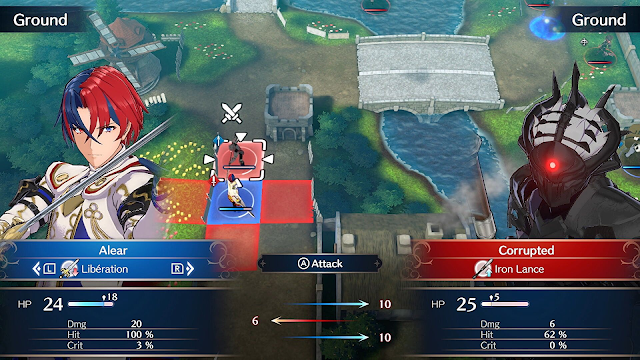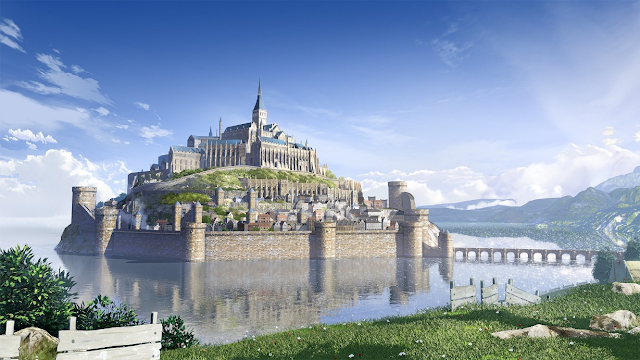Fates: Revelation
Next on the list is Revelation. The easiest way to summarize this map is that it's a Corrin steamroll. It's a map where you have to kill two bosses before Chapter 5. On paper this sounds like a net positive. In practice...well, I'll just quote what somebody else had to say:
"RV: On normal and hard? Easy, just throw Corrin at the enemies as they run toward you. On Lunatic? Fuck this map, never play Revelation Lunatic. You have 5 turns to kill the Nohr mooks, and some genius decided to take away their Wyverns. Usually a lack of Wyverns is a good thing, but this time it means they can't cross the river, and you have to cross the river 1 square at a time yourself. Whoever though this was a good idea should be fed to Lilith.""
"Fuck Revelation's version of this map. Particularly the Lunatic one. Like somebody else has said, you've basically gotta cross the river to bait the cavalier to win. Which is some shit because to do this you have to realize that it's a thing you can do. I mean, I thought of it because of Awakening's water trick, and memories of having Hector ferry mounted units across rivers. But it's such a stupid and obscure thing to actually require from the player at any point in the game - let alone 6 chapters in, without telling or even hinting at the player's ability to Jesus their way across a body of water. For that reason alone Chapter 6 is probably the hardest map in Lunatic Revelation, for all the wrong reasons"
Source for both quotes: https://www.reddit.com/r/fireemblem/comments/65995c/fates_map_discussion_thread_48_chapter_6_all/
Birthright
Are you kidding me? A boss kill map where the boss killer is literally right next to the boss? I get that Birthright is meant to be for beginners, but did the designers just assume that people who are new to the series are idiots? The only reason why it's not listed in the "garbage" tier is because you're given plenty of units to use, and you can choose to give other units experience.
Garbage Tier
As far as I'm concerned, these first chapters have no redeeming qualities. There's an awful lot of them.
Gaiden
Yep. This is the first map of the OG Gaiden. It's a pretty solid indicator of what's to come: An empty field with terrain haphazardly strewn about, and enemies in a random formation. To the game's credit, you at least get to start out with 5 units (Faye doesn't exist in Gaiden). There's very little in the way of strategy here. Maybe getting Tobin and Cliff to promotion level in preparation for the shrine?
Why the other first maps on this list are considered garbage
For the sake of saving time, I figure that since the first maps of these games suffer from the same issues, I can just summarize why they all suck:
- Sacred Stones
- Echoes
- FE 12
- Awakening & Engage: (They basically have the same first chapter)
- Path of Radiance
- The prologue of Fates (yep. The first map of the Fates prologue is in this tier)
1) 2 playable characters or less: All of these first chapters give you two playable characters or less. Technically, Echoes gives you a lot more than just two, but let's not kid ourselves: This map is a Mycen solo. It may as well be a 1 unit map.
As a result of having so few characters, there are very few strategies and ways to replay these maps. That leads to a duller experience all around.
2) Really short map with nothing else going on: All of these maps are really short, and having nothing else to them. I guess Sacred Stones has terrain, but it's a dull implementation of its terrain that just makes it easier for Seth to chokepoint the map. Once again, this hurts replayability.
I get that a designer would want to make their first map simple, but you can have a first chapter that's simple without insulting the player's intelligence, and that's what these first chapters do.
_____________________________________________________________________________
The Multi-Rate Tier
There are two games whose first chapter can be different based on the player's choice. Blazing Sword and Shadow Dragon. Since they rate so differently, they needed their own tier:
Blazing Sword - Lyn Mode: Garbage
There's only one playable character and two enemies. There's nothing else to this map. Textbook example of a map that treats the player like an idiot.
Hector Mode: Meh
You know, this is almost a good map. The biggest problem is that there's only two playable characters here, and only one of them (Hector) is going to be doing any fighting. What's cool about this map is that there are two different methods of approach, and Matthew's thief utility comes in handy here. The lack of a healer makes the map marginally more challenging. Still, it's not bad.
Eliwood Mode: Meh
For a first map, there's nothing super wrong with it, but it's also not super great either. I might rate it higher if that village were actually threatened. Still, 6 playable characters has to count for something. Not much else to say about the map.
Shadow Dragon: Prologue - Garbage
So this map is basically a Marth solo with nothing else that's interesting about it. Joy.
Shadow Dragon Chapter 1











































